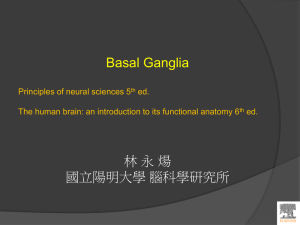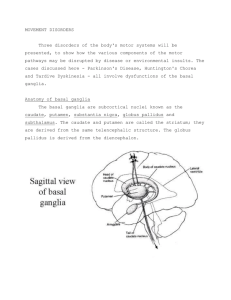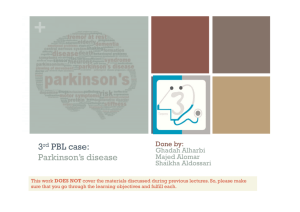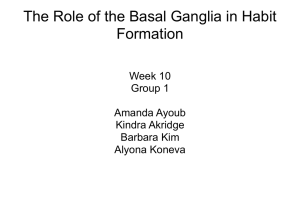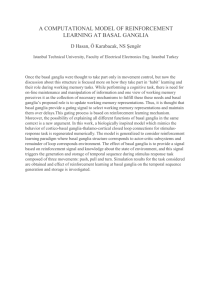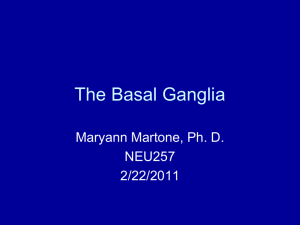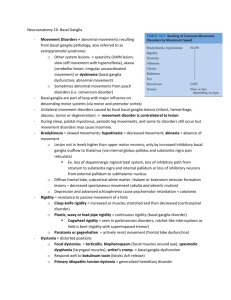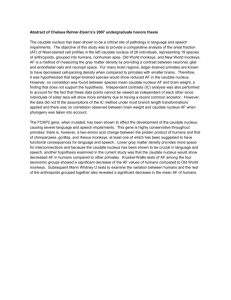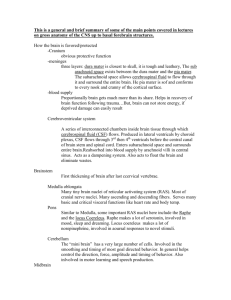basal Ganglia (updated 11-2004) - Cincinnati Children's Hospital
advertisement
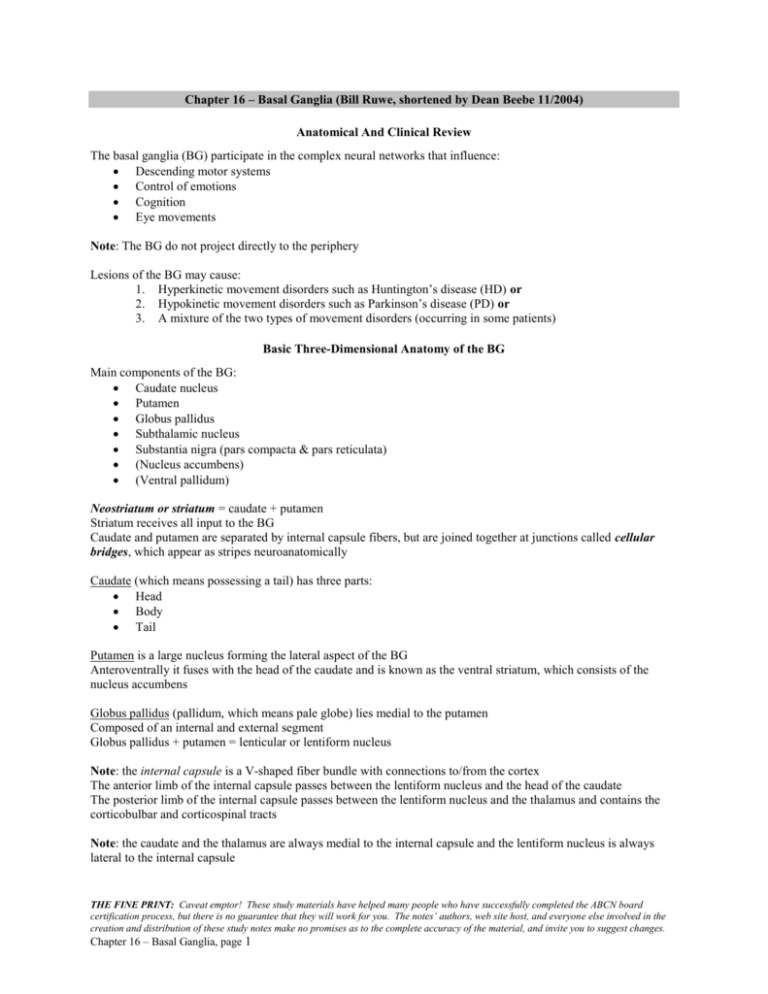
Chapter 16 – Basal Ganglia (Bill Ruwe, shortened by Dean Beebe 11/2004) Anatomical And Clinical Review The basal ganglia (BG) participate in the complex neural networks that influence: Descending motor systems Control of emotions Cognition Eye movements Note: The BG do not project directly to the periphery Lesions of the BG may cause: 1. Hyperkinetic movement disorders such as Huntington’s disease (HD) or 2. Hypokinetic movement disorders such as Parkinson’s disease (PD) or 3. A mixture of the two types of movement disorders (occurring in some patients) Basic Three-Dimensional Anatomy of the BG Main components of the BG: Caudate nucleus Putamen Globus pallidus Subthalamic nucleus Substantia nigra (pars compacta & pars reticulata) (Nucleus accumbens) (Ventral pallidum) Neostriatum or striatum = caudate + putamen Striatum receives all input to the BG Caudate and putamen are separated by internal capsule fibers, but are joined together at junctions called cellular bridges, which appear as stripes neuroanatomically Caudate (which means possessing a tail) has three parts: Head Body Tail Putamen is a large nucleus forming the lateral aspect of the BG Anteroventrally it fuses with the head of the caudate and is known as the ventral striatum, which consists of the nucleus accumbens Globus pallidus (pallidum, which means pale globe) lies medial to the putamen Composed of an internal and external segment Globus pallidus + putamen = lenticular or lentiform nucleus Note: the internal capsule is a V-shaped fiber bundle with connections to/from the cortex The anterior limb of the internal capsule passes between the lentiform nucleus and the head of the caudate The posterior limb of the internal capsule passes between the lentiform nucleus and the thalamus and contains the corticobulbar and corticospinal tracts Note: the caudate and the thalamus are always medial to the internal capsule and the lentiform nucleus is always lateral to the internal capsule THE FINE PRINT: Caveat emptor! These study materials have helped many people who have successfully completed the ABCN board certification process, but there is no guarantee that they will work for you. The notes’ authors, web site host, and everyone else involved in the creation and distribution of these study notes make no promises as to the complete accuracy of the material, and invite you to suggest changes. Chapter 16 – Basal Ganglia, page 1 Substantia nigra Lies just dorsal to the cerebral peduncles Substantia nigra pars reticulata is the ventral portion, which contains cells that are similar to those in the internal segment of the globus pallidus Internal capsule separates the internal segment of the globus pallidus from the substantia nigra pars reticulata Substantia nigra pars compacta is the more dorsal component, which contains the darkly pigmented dopaminergic (DA) cells that give this nucleus its name and distinctive appearance Degeneration of these DA neurons is an important pathogenetic mechanism in PD Subthalamic nucleus, which lies under the thalamus, has a distinct spindle- or cigar-shaped appearance Note: the blood supply to the striatum and globus pallidus is mainly from the lenticulostriate branches of the middle cerebral artery (MCA), although branches of the internal carotid artery and anterior cerebral artery also often supply the medial globus pallidus and the caudate nucleus/lentiform nuclei, respectively. Input, Output, and Intrinsic Connections of the Basal Ganglia Virtually all input to the BG arrives via the striatum (caudate, putamen, & nucleus accumbens) Output leaves the BG via the internal segment of the globus pallidus and the substantia nigra pars reticulata. Four parallel pathways exist within the BG which participate in different functions: 1. General motor control 2. Eye movements 3. Cognitive functions 4. Emotional functions Input to the Basal Ganglia [See Figure 16.5] Cerebral cortex provides the main input to the BG (via the striatum) Putamen is the most important input nucleus for the motor control pathways Most cortical inputs to the striatum are excitatory and use glutamate Substantia nigra pars compacta provides input to the striatum, which is dopaminergic in nature and has both excitatory and inhibitory actions within the striatum Output from the Basal Ganglia [See Figure 16.6] Internal segment of the globus pallidus – conveys information regarding motor control for much of the body Substantia nigra pars reticulata – conveys information regarding motor control for the head and neck Output pathways are inhibitory and use gamma-aminobutyric acid (GABA) Main output pathways are to the ventral lateral (VL) and ventral anterior (VA) nuclei of the thalamus via the thalamic fasciculus. Thalamic neurons convey information from the BG to the entire frontal lobe, although information for motor control travels predominantly to the premotor cortex, supplementary motor area, and the primary motor cortex Additional BG output to the thalamus project to the: Intralaminar nuclei – with projections back to the striatum Mediodorsal nucleus – with extensive connections to the limbic system Additional projections from the GP: Internal segment of the GP and substantia nigra pars reticulata also project to the pontomedullary reticular formation, with influence on the descending reticulospinal tract Substantia nigra pars reticulata also projects to the superior colliculus, which influences the tectospinal pathways THE FINE PRINT: Caveat emptor! These study materials have helped many people who have successfully completed the ABCN board certification process, but there is no guarantee that they will work for you. The notes’ authors, web site host, and everyone else involved in the creation and distribution of these study notes make no promises as to the complete accuracy of the material, and invite you to suggest changes. Chapter 16 – Basal Ganglia, page 2 Hyperkinetic and Hypokinetic Movement Disorders Parkinson’s disease DA-containing neurons in the substantia nigra pars compacta degenerate DA excites neurons of the direct pathway and inhibits neurons of the indirect pathway, with a net excitatory action on the thalamus Loss of DA results in net inhibition of the thalamus, leading to the paucity of movements in PD Aspiny neurons are large interneurons located in the striatum, which contain acetylcholine (ACh) These interneurons may preferentially form excitatory synapses onto striatal neurons of the indirect pathway and removal of the cholinergic excitation leads to a net decrease of thalamic inhibition Anticholinergic drugs often are beneficial in the treatment of PD Hemiballismus is characterized by wild flinging movements of the extremities contralateral to the lesion in the basal ganglia This typically involves damage to the subthalamic nucleus, which likely decreases excitation of the internal segment of the globus pallidus, resulting in less inhibition of the thalamus hyperkinetic disorder Huntington’s disease (HD) Characterized by degeneration of striatal neurons in the caudate and putamen, with perhaps the most severe destruction occurring in the enkephalin-containing striatal neurons of the indirect pathway Removal of inhibition from the external segment of the globus pallidus, thereby permitting it to inhibit the subthalamic nucleus In advanced stages of HD both direct and indirect pathways degenerate, resulting in a rigid hypokinetic parkinsonian state Parallel Basal Ganglia Pathways for Movement, Eye Movement, Cognition and Emotion Motor channel Best known channel, with cortical inputs to the putamen and output from the internal segment of the globus pallidus and the substantia nigra pars reticulata, with connections to the VL and VA nuclei of the thalamus Thalamic outputs project to the supplementary motor cortex, premotor cortex, and primary motor cortex Oculomotor channel Involved in the mediation of eye movements Input for this channel is derived primarily from the body of the caudate nucleus Output reaches the frontal eye fields and the supplementary eye fields of the frontal lobes and is involved in higher control of eye movements Prefrontal channel Involved in the cognitive processes mediated by the frontal lobes (i.e., executive functions) Input is derived primarily from the head of the caudate and output is largely to the prefrontal cortex Limbic channel Important ventral pathway through the basal ganglia, which is involved in limbic regulation of emotions and motivational drives Input arises from major areas of the limbic system (e.g., limbic cortex, hippocampus, and amygdala), which travel to the nucleus accumbens and other regions of the ventral striatum Output arises from the ventral pallidum and project to thalamic nuclei (e.g., mediodorsal and ventral anterior nuclei), which project on to the limbic cortex of the anterior cingulate gyrus and medial orbital frontal nuclei Another component of this pathway arises from the DA neurons of the ventral tegmental area (located medial and dorsal to the substantia nigra of the midbrain) The ventral tegmental area projects to the nucleus accumbens, other limbic structures, and the frontal lobes, and may be involved in the pathophysiology of schizophrenia THE FINE PRINT: Caveat emptor! These study materials have helped many people who have successfully completed the ABCN board certification process, but there is no guarantee that they will work for you. The notes’ authors, web site host, and everyone else involved in the creation and distribution of these study notes make no promises as to the complete accuracy of the material, and invite you to suggest changes. Chapter 16 – Basal Ganglia, page 3 MOVEMENT DISORDERS – Key Clinical Concept Abnormal movements can be caused by dysfunction anywhere in the complex hierarchical motor network with the central and/or peripheral nervous system Movement disorders typically refer to abnormal movements resulting from pathology in the BG Note: The basal ganglia are part of a network of complex loops that exert their influence on the descending motor systems through their projections to the motor and premotor cortex, although they are sometimes referred to as “extrapyramidal syndromes” Nomenclature: Spasticity – slow, clumsy, stiff movements and hyperreflexia resulting from corticospinal, upper motor neuron lesions Ataxia – irregular, uncoordinated movements caused by lesions of cerebellar circuitry Dyskinesia – abnormal movements caused by basal ganglia dysfunction; Rule out for dyskinesia should include abnormalities in upper or lower motor neuron signs, sensory loss or ataxia Note: Abnormal movements also may be caused by psychological conditions such as Conversion Disorder Classifying Movement Disorders Slow to fast – One common, albeit simplified, way of classifying movement disorders is on a spectrum from slow to fast Movement disorders also may be classified as: Focal or generalized Unilateral or bilateral Note: In unilateral movement disorders caused by focal lesions within the BG (e.g., caused by infarct, hemorrhage, abscess, tumor, or degeneration), the movement disorder is contralateral to the lesion of the basal ganglia During sleep, most movement abnormalities cease, with the exception of palatal myoclonus and some tic disorders, but can occur on a milder basis which can result in sleep disturbances Bradykinesia, Hypokinesia, Akinesia Bradykinesia or “slowed movements” are often caused by increased inhibitory outflow from the BG to the thalamus E.g., loss of function of DA nigrostriatal system, loss of inhibitory pathways from the striatum to the substantia nigra and internal pallidum, or loss of inhibitory projections from the external pallidum to the subthalamic nucleus Hypokinesia or “decreased amount of movements” Decreased spontaneous movements without coma may result from diffuse lesions of the frontal lobes, subcortical white matter, thalami, or brainstem reticular formation as well as the basal ganglia Akinesia or “absence of movement” These terms typically are used for dysfunction localized at levels higher than the upper motor neurons (i.e., corticospinal, corticobulbar, lower motor neuron, or muscular disorders) Prominent disorders are associated with these movement abnormalities (e.g., Parkinson’s disease, abulia, akinetic mutism, & catatonia) Rigidity Increased resistance to passive movement of a limb, which is often present in disorders that cause bradykinesia or dystonia Rigidity may be velocity-dependent, as in the clasp-knife rigidity of corticospinal disorders (the resistive tone initially increases as the muscles of the limb are stretched, and is then followed by a decrease in tone) THE FINE PRINT: Caveat emptor! These study materials have helped many people who have successfully completed the ABCN board certification process, but there is no guarantee that they will work for you. The notes’ authors, web site host, and everyone else involved in the creation and distribution of these study notes make no promises as to the complete accuracy of the material, and invite you to suggest changes. Chapter 16 – Basal Ganglia, page 4 Rigidity characteristic of the BG disorders is more continuous throughout attempts to move the limb and is often described as plastic, waxy or lead pipe rigidity In PD, the characteristic cogwheel rigidity is a form of plastic rigidity in which there are ratchet-like interruptions in tone that can be felt as the limb is bent Paratonia or gegenhalten is a condition observed in patients with frontal lobe lesions in which there is active resistance of movement of their limbs. This has a more active, inconsistent, or quasi-voluntary quality Dystonia Patient assumes abnormal, distorted positions of the limbs, trunk or face that are more sustained or slower than in athetosis Three forms of dystonia are: 1. generalized, 2. unilateral or 3. focal Focal dystonias believed to be due to BG dysfunction include: Torticollis, which involves the muscles of the neck Blepharospasm, which involves the facial muscles around the eyes Spasmodic dysphonia, which involves the laryngeal muscles Writer’s cramp Treatment includes “botox” or botulinum toxin injections into the muscles, which are repeated every few months; Botox acts by interfering with presynaptic release of ACH at the neuromuscular junction Primary idiopathic torsion dystonia (formerly known as dystonia musculorum deformans) Uncommon hereditary disorder that causes generalized dystonia Dystonia also may occur secondary to damage of the BG associated with tumors, abscesses, infarcts, carbon monoxide poisoning, Wilson’s disease, PD, and HD Dystonias or faster dyskinesias (e.g., athetosis or chorea) may be seen with acute or chronic use of dopaminergic antagonists, such as antipsychotics or anti-emetics Long-term use of DA antagonists may cause tardive dyskinesia with prominent oral and/or lingual choreic dyskinesias Wilson’s disease - an autosomal recessive disorder of biliary copper excretion that causes progressive degeneration of the liver and BG Typical neurologic manifestations of Wilson’s disease include: Gradual onset dysarthria Dystonia (facial dystonia causing a wry smile called risus sardonicus) Rigidity Tremor (e.g., “wing-beating” with arm abduction and elbow flexion) Choreathetosis Prominent psychiatric disturbances Brownish outer corneal deposits of copper (i.e., Kayser-Fleischer rings) Treatment for Wilson’s disease typically includes copper chelating agents (e.g., penicillamine) (which can arrest progress of the disorder) Athetosis Characterized by twisting movements of the limbs, face, and trunk that sometimes merge with faster choreic movements, hence the term choreoathetosis May occur secondary to perinatal hypoxia, severe neonatal jaundice, Wilson’s disease, ataxia telangiectasia, HD, antipsychotic or anti-emetic medications, and levodopa in PD patients THE FINE PRINT: Caveat emptor! These study materials have helped many people who have successfully completed the ABCN board certification process, but there is no guarantee that they will work for you. The notes’ authors, web site host, and everyone else involved in the creation and distribution of these study notes make no promises as to the complete accuracy of the material, and invite you to suggest changes. Chapter 16 – Basal Ganglia, page 5 Chorea Characterized by continuous involuntary movements that have a fluid or jerky, constantly varying quality Ranges from mild “fidgeting’ to violent frantic “break dancing” May involve proximal or distal extremities, the trunk, neck, face, and/or respiratory muscles Huntington’s disease – major cause of chorea, which is an autosomal dominant neurodegenerative disorder Characterized by chorea, severe neuropsychiatric disturbances, and ultimately inability to walk Patients often die about 15 years after onset, usually from respiratory infections Benign familial chorea – autosomal dominant inheritance, but nonprogressive form of chorea, without cognitive or emotional decline Sydenham’s chorea (rheumatic chorea) – rare except in untreated streptococcal infections, with onset typically in adolescence and more often in females The fidgetiness and emotional lability may be accompanied by impulsive or obsessive-compulsive behaviors Believed to be caused by cross-reaction of antistreptococcal antibodies with striatal neurons Systematic lupus erythematosus (SLE) – another cause of chorea in young females - Chorea may be the first manifestation of SLE Chorea gravidarum – chorea occurring during pregnancy or while on oral contraceptives may represent an initial episode or recurrence of SLE or Sydenham’s chorea Chorea – dyskinetic side effect of levodopa in PD or tardive side effect secondary to antipsychotics or antiemetics Numerous other conditions may cause chorea, such as perinatal anoxia; hyperthyroidism; hypoparathyroidism; electrolyte, amino acid or glucose abnormalities; drugs; Wilson’s disease; or Lesch-Nyham syndrome Hemichorea – may occur contralateral to focal lesions of the BG Ballismus (or ballism) Movements of the proximal limb muscles with a large-amplitude, more rotatory or flinging quality Hemiballismus – the most common type, in which there are unilateral flinging movement of the extremities contralateral to the lesion in the BG Classically caused by a lacunar infarct of the subthalamic nucleus (sometimes striatum), with subsequent decreased pallidal inhibition of the thalamus Typically disabling movements may be attenuated by haloperidol (DA antagonist) Tics A sudden brief action that is preceded by an urge to perform it and which is followed by a sense of relief 1. Motor tics – usually involve the face and neck (less often the extremities) 2. Vocal tics – brief grunts, coughing sounds, howling/barking, or elaborate vocalizations including coprolalia (obscenities) May be observed as transient single motor or vocal tics of childhood or in the more pronounced Tourette’s syndrome Tourette’s syndrome – four times more common in boys, with an apparent autosomal dominant inheritance pattern Onset is usually in late childhood and may be accompanied by ADHD or obsessive-compulsive disorders Symptoms wax and wane, and may remit partially during adolescence Tics may occur as consequences of lesions such as encephalitis, infarcts, hemorrhage, or tumors Treatment usually entails counseling and psychoeducation, but may include DA antagonists (e.g., haloperidol or pimozide) or clonidine (2-receptor antagonist) THE FINE PRINT: Caveat emptor! These study materials have helped many people who have successfully completed the ABCN board certification process, but there is no guarantee that they will work for you. The notes’ authors, web site host, and everyone else involved in the creation and distribution of these study notes make no promises as to the complete accuracy of the material, and invite you to suggest changes. Chapter 16 – Basal Ganglia, page 6 Myoclonus A sudden rapid muscular jerk that can be focal, unilateral or bilateral, which is usually considered to be the fastest of all motor disorders Numerous etiologies with many possible central locations of lesions (e.g., cortex, cerebellum, BG, brainstem or spinal cord (SC) Common causes include anoxic brain injury, encephalitis, toxic or metabolic encephalopathies, paraneoplastic disorders (e.g., lung carcinoma, ovarian or breast carcinoma, & neuroblastoma) Tics are not infrequent in epileptic cortical activity such as juvenile myoclonic epilepsy Note: myoclonus also is prominent in cortical basal ganglionic degeneration and in prion-related diseases such as Creutzfeldt-Jakob disease, and in later stages of Lewy body disease or Alzheimer’s disease (AD) Palatal myoclonus – markedly rhythmic and notably persistent during sleep, with movements of the palate occurring at a rate of 1 – 2 hertz and sometimes extending to the face or proximal upper extremities Typically caused by lesions of the central tegmental tract Asterixis (meaning “lack of fixed position”) – or flapping tremor Often seen in metabolic or toxic encephalopathies, especially in hepatic failure in which it is known as “liver flap” If the patient is asked to hold their arms in front of their chest, with palms facing forward from extended wrists, an intermittent flexion movement occurs at the wrists bilaterally Not caused by muscle contractions but by brief interruptions in contractions of the wrist extensors Tremor Rhythmic or semi-rhythmic oscillating movements, which differ from myoclonus and asterixis in that both agonist and antagonist muscles are activated, causing the bi-directional movements Resting tremor – a frequency of 3 to 5 hertz, which is most prominent when the limbs are relaxed, with decreased or absent tremor when the patient moves the limbs Important feature of PD and is often called parkinsonian tremor, which is often asymmetrical and usually involves the hands and upper extremities Also known as pill-rolling tremor because pts appear to be rolling something between thumb and fingers Postural tremor – a frequency of 5 to 8 hertz, most prominent when the patient’s limb actively held in position Note: Essential tremor is the most common type of postural tremor and may be the most common of all movement disorders Also known as familial, benign, or senile tremor Most commonly involves the hands or arms, but may affect the jaw, tongue, lips, head, or vocal cords Usually bilateral, but may be asymmetrical Increases with stress, but can be relieved by -adrenergic antagonists (e.g., propranolol), with advanced cases responsive to ventrolateral thalamotomy or thalamic stimulation May be familial, with autosomal dominant inheritance Onset from early adulthood to advanced age Intention tremor (ataxic tremor) – with a frequency of 2 to 4 hertz, is usually a feature of appendicular ataxia associated with cerebellar disorders Occurs as the patient attempts to move their limb toward a target, and is characterized by irregular, oscillating movements in multiple planes throughout the trajectory Other Terms Related to Tremor Action tremor – postural or intention tremor Static tremor – resting or postural tremor Kinetic tremor – intention tremor Terminal tremor – tremor that increases toward the end of a mvmt (often the case w/ intention tremor) THE FINE PRINT: Caveat emptor! These study materials have helped many people who have successfully completed the ABCN board certification process, but there is no guarantee that they will work for you. The notes’ authors, web site host, and everyone else involved in the creation and distribution of these study notes make no promises as to the complete accuracy of the material, and invite you to suggest changes. Chapter 16 – Basal Ganglia, page 7 Tremors Secondary to Cerebellar Lesions Rubral tremor – most likely caused by lesions of the superior cerebellar peduncles or other cerebellar circuitry (not due to damage to the red nucleus), but also may be caused by multiple sclerosis (MS) or brainstem infarcts Frequency of 2 to 4 hertz Head and trunk titubation – secondary to lesions of the vermis Palatal myoclonus – typically classified as a tremor rather than a myoclonus Physiological tremor – frequency of 8 to 13 hertz, which is believed to be caused by enhancement of the normal tremor present in all individuals Postural tremors may be caused by drugs, medications, metabolic derangements, alcohol withdrawal, intense fear, anxiety and other conditions Parkinson’s Disease (PD) and Related Disorders – Key Clinical Concept Parkinson’s Disease (PD) Common idiopathic neurodegenerative condition caused by loss of DA neurons in the substantia nigra pars compacta Characteristic Symptoms of PD include: Asymmetrical resting tremor Bradykinesia Rigidity Postural instability PD usually responds well to treatment with levodopa Note: parkinsonism and parkinsonian signs are general terms that refer to conditions with features similar to PD Idiopathic Parkinson’s Disease [See Figure 16.10 for Pathologic Changes of PD] A condition with unknown etiology and a common onset between the ages of 40 and 70 Generally no familial tendency Loss of pigmented DA neurons in the substantia nigra pars compacta, which causes the characteristic pale appearance of this area Remaining neurons often contain cytoplasmic inclusions or Lewy bodies (eosinophilic, containing ubiquitin, & -synuclein and have a faint halo) Classic Symptom Triad of PD Diagnosis of idiopathic PD is based on clinical features, which typically include: 1. Resting tremor (“pill-rolling” tremor) 2. Bradykinesia 3. Rigidity (cogwheel) These are accompanied typically by postural instability (plus stooped appearance and dystonic features) that causes an unsteady gait Even severe forms typically remain asymmetrical and are responsive to levodopa Progression is usually insidious, occurring over the course of 5 to 15 years Other Clinical Features of Idiopathic PD Masked facies or hypomimia – decrease in spontaneous blink rate and in facial expression Hypophonic voice – hurried, muttering quality Micrographia – small writing Abnormal saccadic eye movements – slow and broken into catch-up saccades Retropulsion – if the patient is pulled backward slightly, a series of several backward steps are taken to regain balance Festinating gait – gait characterized by small, shuffling steps Anteropulsion – appear to be continually falling and shuffling forward En bloc turning – turns are executed without the normal twist of the torso Myerson’s sign – inability to suppress blinking when the glabella (center of the brow) is tapped repeatedly THE FINE PRINT: Caveat emptor! These study materials have helped many people who have successfully completed the ABCN board certification process, but there is no guarantee that they will work for you. The notes’ authors, web site host, and everyone else involved in the creation and distribution of these study notes make no promises as to the complete accuracy of the material, and invite you to suggest changes. Chapter 16 – Basal Ganglia, page 8 Dementia – not an early feature of PD, but may occur in 15 to 40% or more of the late-course PD patients, which may be coincident with Lewy body disease or AD Bradyphrenia – responses are slowed, but typically are accurate when given sufficient time Depression and anxiety – common in advanced PD Treatment of PD Levodopa – the most effective drug, with most formulations containing carbidopa, a decarboxylase inhibitor that cannot cross the blood-brain barrier (BBB) Carbidopa inhibits the breakdown of levodopa to DA in peripheral tissues, thereby increasing the levodopa available for conversion to DA in the brain “On-Off Phenomena” “Wearing off” – seen in levodopa therapy and occurring toward the end of the time between doses Patient may experience “freezing” and be unable to move, or fluctuate between this and dyskinesias Other Treatments Anticholinergic agents such as Cogentin (benztropine mesylate) or Artane (trihexyphenidyl) Amantadine – increases DA release, as well as serving as an anticholinergic and antiglutaminergic agent DA agonists – including pergolide, bromocriptine, ropinole, and pramipexole Stereotactic surgery may also be used– pallidotomy, in which the lesion is placed within the globus pallidus, which can help with the “negative” symptoms, or thalamotomy, in which the lesion is placed in the ventral lateral thalamic nucleus, which can help with tremor (mnemonic: T for tremor) Other Causes of Parkinsonism Symptoms 1. Dopaminergic antagonists – haloperidol (Haldol) or prochlorperazine (Compazine) may cause parkinsonian signs but usually the onset is abrupt and the symptoms are symmetrical 2. Neurodegenerative disease – or parkinsonism plus syndromes Produce atypical parkinsonism, which is characterized by relatively symmetrical symptoms, absence of resting tremor, and lessened response to DA agents 3. Multisystem atrophy – neurodegenerative conditions which include striatonigral degeneration, Shy-Drager syndrome, and olivopontocerebellar atrophy 4. Progressive Supranuclear Palsy (PSP) Also known as Steele-Richardson-Olszewski syndrome Characterized by degeneration in multiple structures around the midbrain-diencephalic junction (e.g., superior colliculus, red nucleus, dentate nucleus, subthalamic nucleus, and globus pallidus) Vertical eye movement – range is quite limited for both upward and downward saccades Other features of PSP include waxy rigidity, bradykinesia, frequent falling, and a “wide-eyed stare” 5. Dementia with Lewy Bodies or Diffuse Lewy Body Disease Lewy bodies are localized in the substantia nigra and throughout the cerebral cortex Features include prominent psychiatric symptoms (visual hallucinations), with episodic exacerbations 6. Cortical Basal Ganglionic Degeneration – parkinsonism that resembles PD with marked cortical features including apraxia and corticospinal abnormalities 9. Huntington’s disease – also is a trinucleotide repeat disorder that can cause parkinsonism features – early onset can lead to Parkinson-type symptoms 10. Wilson’s disease – may cause tremor, rigidity and bradykinesia MPTP – parkinsonism features secondary to this toxin ontained in a synthetic heroin-like meperidine analog 11. Dementia Pugilistica – characterized by parkinsonism and cognitive decline Rule Outs for Parkinsonism: Hydrocephalus Frontal lobe lesions Diffuse subcortical disorders and Depression THE FINE PRINT: Caveat emptor! These study materials have helped many people who have successfully completed the ABCN board certification process, but there is no guarantee that they will work for you. The notes’ authors, web site host, and everyone else involved in the creation and distribution of these study notes make no promises as to the complete accuracy of the material, and invite you to suggest changes. Chapter 16 – Basal Ganglia, page 9 Huntington’s Disease – Key Clinical Concepts Autosomal dominant neurodegenerative disease, characterized by: a progressive, typically choreiform, movement disorder dementia psychiatric disturbances Prevalence: 4 – 5 cases per million (higher in those of northern European ancestry) Onset: usually from 30 – 50 years of age Initial symptoms: subtle chorea and behavioral disturbances Median survival from onset of first symptoms is 15 years Genetics Gene is located on chromosome 4 and is characterized by an abnormally high number of CAG repeats (i.e., trinucleotide sequence), with normal individuals usually having 30 or fewer and those with, or likely to develop, HD having over 40 (Note that a higher number leads to earlier onset) HD gene encodes a protein called huntingtin Genetic testing permits identification of those likely to develop the disorder Neuropathologic hallmark of HD: Progressive atrophy of the striatum, especially the caudate nucleus Atrophy occurs in the putamen and nucleus accumbens, with degeneration usually affecting the striatal neurons of the indirect pathway Lateral ventricles may appear enlarged secondary to atrophy of the caudate and putamen Clinical manifestations include abnormalities of: Body movements Eye movements Emotions, and Cognition Early movement abnormalities include: clumsiness and subtle chorea (e.g., mild jerking & fidgety movements), tics, athetosis, and dystonic posturing Eye movement abnormalities often include: slow saccades, impaired smooth pursuit, sluggish optokinetic nystagmus, and characteristic difficulty initiating saccades without moving the head or blinking Common Psychiatric Symptoms of HD Include: Affective disorders (e.g., depression & anxiety) Obsessive-compulsive disorder Impulsive or destructive manic-like behavior Psychosis (occasionally) Multiple cognitive impairments associated with HD include: Decreased attention Memory disorder (recent and remote) Anomic aphasia Impaired executive functions Note: In advanced HD, profound dementia and loss of almost all purposeful movements occur Treatment: Primary goal is to alleviate symptoms, typically with anti-DA agents and control psychiatric manifestations with counseling and psychotropics THE FINE PRINT: Caveat emptor! These study materials have helped many people who have successfully completed the ABCN board certification process, but there is no guarantee that they will work for you. The notes’ authors, web site host, and everyone else involved in the creation and distribution of these study notes make no promises as to the complete accuracy of the material, and invite you to suggest changes. Chapter 16 – Basal Ganglia, page 10 Brief Anatomical Study Guide Basal Ganglia provide complex feedback loops that influence descending motor pathways Main components include: Caudate nucleus Putamen Globus pallidus Subthalamic nucleus Substantia nigra Striatum = caudate + putamen Lentiform nucleus = putamen + globus pallidus Internal capsule – forms a sideways V-shaped demarcation with the thalamus and the caudate nucleus lying medial to the internal capsule and the lentiform nucleus lying laterally Input and Output All input enters the BG via the striatum: Input from the motor and premotor cortex DA input from the substantia nigra pars compacta Thalamic nuclei (intralaminar nuclei) All output leaves via the internal segment of the globus pallidus and the substantia nigra pars reticulata Thalamic ventral anterior (VA) and ventral lateral (VL) Other thalamic nuclei Brainstem reticular formation Tectum Hyperkinetic and Hypokinetic Movement Disorders HD – hyperkinetic movement disorder The inhibitory output from the BG to the thalamus is decreased, leading to a relative disinhibition of the descending motor systems E.g., infarcts that destroy the subthalamic nucleus which cause hemiballismus or Loss of inhibitory GABAergic neurons from the striatal neurons of the indirect pathway that causes HD PD – hypokinetic movement disorder The inhibitory output from the BG to the thalamus is increased, resulting in a paucity of movement Typically degeneration of the DA neurons that project from the substantia nigra pars compacta to the striatum Mediation of Four Parallel Channels by the Basal Ganglia General motor functions with input primarily from the putamen Eye movements with input from body of the caudate Frontal executive functions with input from the head of the caudate Limbic functions which involves ventral structures (e.g., nucleus accumbens & ventral pallidum) Clinical manifestations of damage to the BG include prominent oculomotor, cognitive and psychiatric manifestations in addition to the pronounced motor disorders THE FINE PRINT: Caveat emptor! These study materials have helped many people who have successfully completed the ABCN board certification process, but there is no guarantee that they will work for you. The notes’ authors, web site host, and everyone else involved in the creation and distribution of these study notes make no promises as to the complete accuracy of the material, and invite you to suggest changes. Chapter 16 – Basal Ganglia, page 11
